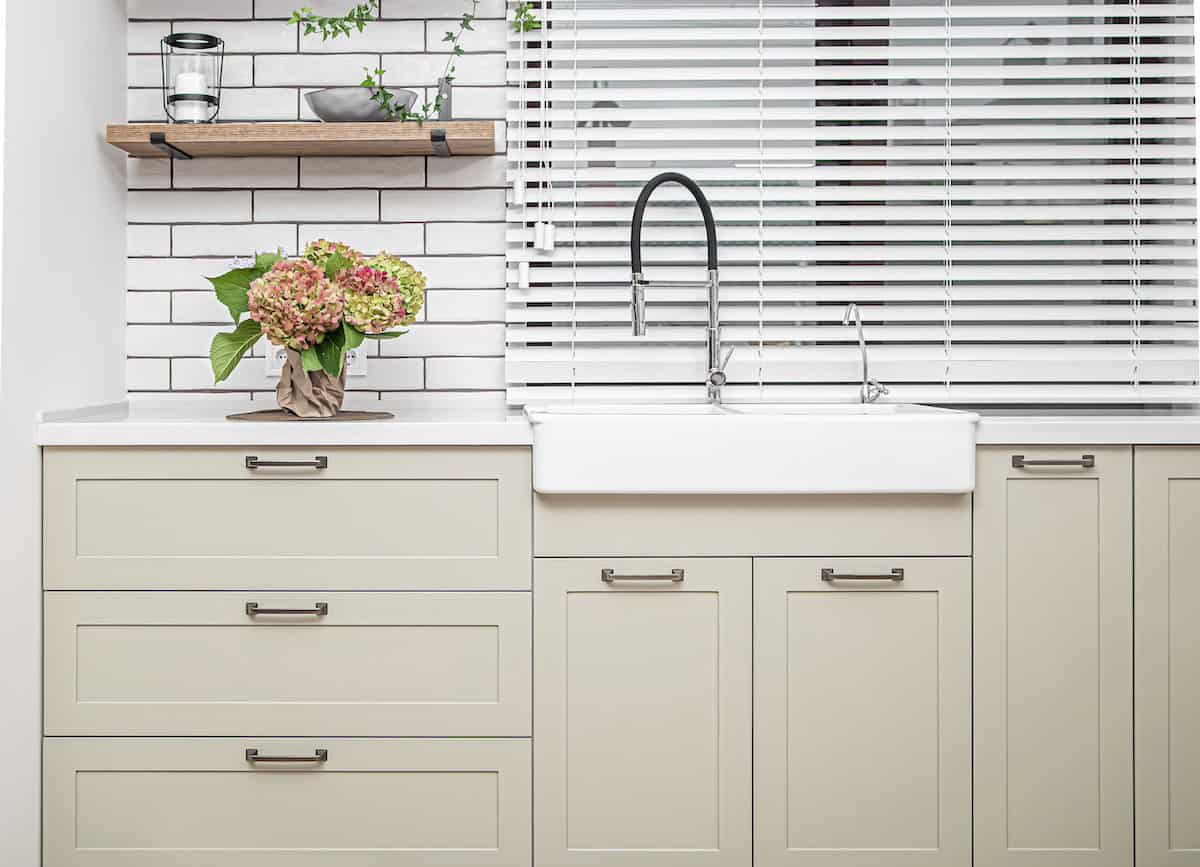
08 Aug What Are The Best Wood Finishes To Use On Kitchen Cabinets?
The Finish Is A Good Place To Start
Choosing the right finish for your kitchen cabinets is a crucial decision that impacts not only the aesthetics of your kitchen but also its functionality and durability. The finish of your cabinets determines how they look, how well they withstand daily wear and tear, and how easy they are to maintain. Here’s why selecting the appropriate finish is so important.
Aesthetic Appeal
The finish you choose plays a significant role in your kitchen’s overall look and feel. It can highlight the natural beauty of the wood, complement your kitchen’s design style, and create a cohesive look. For instance, a high-gloss finish can give a modern, sleek appearance, while a matte or satin finish can offer a more traditional or rustic feel. Stains and paints come in various colors, allowing you to customize your kitchen to match your taste and your home’s existing décor.
Durability and Protection
The kitchen is one of the most high-traffic areas in a home, subject to heat, moisture, grease, and frequent use. A good finish acts as a protective layer that shields the cabinets from these elements.
For example, a polyurethane finish provides a hard, durable surface that resists scratches and stains. On the other hand, an oil-based finish can penetrate the wood, offering protection from within. Choosing a finish that provides adequate protection ensures your cabinets remain in good condition for longer, ultimately saving you money on repairs or replacements.
At Ultimate Cabinets, we use a baked-on water-based finish with the durability and non-yellowing characteristics of conversion varnish without the associated environmental issues.
Maintenance and Cleaning
The ease of cleaning and maintaining your cabinets is directly related to the type of finish you choose. High-gloss and semi-gloss finishes are more effortless to clean because they are less porous and more resistant to stains and grime.
Simply wiping them down with a damp cloth can remove most dirt and spills. While trendy and stylish, matte finishes might show fingerprints and smudges more easily and can be more challenging to clean. Understanding the maintenance requirements of different finishes helps you choose one that fits your lifestyle and how much time you’re willing to spend on upkeep.
Environmental Considerations
Some finishes are more environmentally friendly than others. Water-based finishes, for example, emit fewer volatile organic compounds (VOCs) than oil-based finishes, making them a healthier choice for indoor air quality. If sustainability is your priority, looking for low-VOC or zero-VOC finishes can help reduce your environmental footprint.
Cost Implications
The cost of finishes can vary widely. High-end finishes like catalyzed varnishes or custom stains can be more expensive but offer superior durability and appearance. However, if you’re on a tight budget, plenty of affordable options still provide good protection and a decent look. Balancing your budget with your desired level of quality and appearance is key.
Wood Finish For Your Kitchen
Wood finishes are essential for enhancing the appearance and longevity of wood surfaces. They bring out the natural beauty of the wood grain, adding depth and richness to the material. Finishes also protect against moisture, heat, and daily wear and tear, preventing damage like scratches, stains, and warping. Wood finishes make surfaces easier to clean and maintain, ensuring they look good and last longer.
With various options, including eco-friendly choices, wood finishes can suit different aesthetic preferences and functional needs, making them a valuable addition to any wooden surface.
Choosing the best wood finish for kitchen cabinets is a critical aspect of kitchen design, influencing both the appearance and longevity of the cabinets. The right finish can enhance the natural beauty of the wood, protect it from daily wear and tear, and ensure easy maintenance. Here are some of the best wood finishes for kitchen cabinets, each with unique benefits and characteristics.
1. Lacquer Finishes
Lacquer is a popular choice for kitchen cabinets due to its high durability and ability to provide a smooth, glossy finish. It dries quickly, allowing multiple coats to be applied quickly. Lacquer finishes are available in various sheens, from matte to high gloss, enabling customization to match any kitchen style.
Pros:
- Provides a hard, durable surface
- Dries quickly
- Easy to apply and reapply
- Available in a variety of sheens
Cons:
- Requires proper ventilation due to fumes
- Can yellow over time, especially in direct sunlight
2. Polyurethane Finishes
Polyurethane is known for its excellent durability and water resistance, making it ideal for kitchen cabinets. It forms a tough, protective layer that resists scratches, stains, and heat, ensuring the cabinets remain in good condition even with frequent use.
Pros:
- Extremely durable and resistant to water and heat
- Available in oil-based and water-based formulas
- It provides a clear finish that enhances the wood grain
Cons:
- Oil-based polyurethane can turn yellow over time
- Water-based polyurethane might not be as durable as oil-based
3. Conversion Varnish
Conversion varnish is a high-performance finish used in professional applications. It provides exceptional durability and chemical resistance, making it perfect for high-traffic areas like kitchens. Due to its complex curing process, this finish requires professional application.
Pros:
- Superior durability and chemical resistance
- Provides a smooth, even finish
- Excellent protection against moisture and heat
Cons:
- Requires professional application
- Expensive compared to other finishes
4. Shellac Finishes
Shellac is a natural resin that provides a beautiful, warm finish that enhances the wood’s natural color and grain. It is quick-drying and easy to apply, making it a favorite among DIY enthusiasts. However, shellac is not as durable as other finishes and is susceptible to water and heat damage.
Pros:
- Easy to apply and repair
- Provides a warm, rich finish
- Non-toxic and environmentally friendly
Cons:
- Less durable than other finishes
- Susceptible to water and heat damage
5. Water-Based Finishes
Water-based finishes are becoming increasingly popular due to low VOC (volatile organic compounds) content and minimal environmental impact. They provide a clear, non-yellowing finish that is easy to clean and maintain.
Pros:
- Low VOC content and environmentally friendly
- Dries quickly and cleans up easily with water
- Provides a clear, non-yellowing finish
Cons:
- Less durable than oil-based finishes
- Requires more coats for the same level of protection
6. Oil Finishes
Oil finishes, such as tung and linseed, penetrate the wood to enhance its natural beauty and provide a warm glow. These finishes are easy to apply and repair but require regular maintenance to maintain their appearance and protective qualities.
Pros:
- Enhances the natural beauty of the wood
- Easy to apply and repair
- Non-toxic and safe for food contact surfaces
Cons:
- Requires regular maintenance
- Less protective than film-forming finishes
7. Stain and Sealer Combination
Stain and sealer combinations are convenient because they provide color and protection in one step. These products are available in various colors, allowing customization of the wood’s appearance while providing a protective layer.
Pros:
- Saves time by combining staining and sealing
- Available in a wide range of colors
- Provides good protection against moisture and wear
Cons:
- Limited control over the final color compared to separate stain and sealer
- May require multiple coats for adequate protection
8. Painted Finishes
While not technically a wood finish, painted finishes are popular for kitchen cabinets due to their ability to completely transform their appearance. High-quality cabinet paints provide excellent durability and are available in various colors.
Pros:
- Wide range of color options
- Can cover imperfections in the wood
- Durable and easy to clean
Cons:
- Hides the natural beauty of the wood
- Can chip or peel over time, requiring touch-ups
Make Your Kitchen Stand Out
Choosing the best wood finish for kitchen cabinets involves balancing aesthetics, durability, maintenance, and environmental considerations. Lacquer, polyurethane, and conversion varnish offer excellent durability and protection, making them ideal for high-traffic kitchens. Shellac and oil finishes provide a warm, natural look but require more maintenance.
Water-based finishes are eco-friendly and easy to work with, while stain and sealer combinations offer convenience. Painted finishes provide a wide range of color options, allowing for complete customization.
Ultimately, the best finish for your kitchen cabinets will depend on your specific needs and preferences. By understanding the benefits and drawbacks of each type of finish, you can make an informed decision that enhances the beauty and functionality of your kitchen.



Sorry, the comment form is closed at this time.